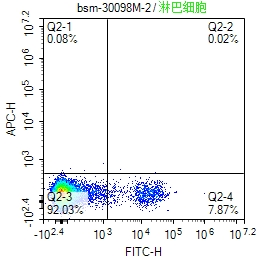
Mouse Anti-human CD20 antibody
CD20_HUMAN; B-lymphocyte antigen CD20; B-lymphocyte surface antigen B1; Bp35; Leukocyte surface antigen Leu-16; Membrane-spanning 4-domains subfamily A member 1; MS4A1; MS4A2; B1; CVID5; LEU-16; S7.
View History [Clear]
Details
Product Name human CD20 Chinese Name 小鼠抗人CD20单克隆抗体 Alias CD20_HUMAN; B-lymphocyte antigen CD20; B-lymphocyte surface antigen B1; Bp35; Leukocyte surface antigen Leu-16; Membrane-spanning 4-domains subfamily A member 1; MS4A1; MS4A2; B1; CVID5; LEU-16; S7. Research Area Tumour immunology Stem cells Cell Surface Molecule b-lymphocyte Immunogen Species Mouse Clonality Monoclonal Clone NO. HI20a React Species Human, Applications Flow-Cyt=2ul/Test
not yet tested in other applications.
optimal dilutions/concentrations should be determined by the end user.Theoretical molecular weight 33kDa Detection molecular weight 33-37 Cellular localization The cell membrane Form Liquid Concentration 1mg/ml immunogen KLH conjugated synthetic peptide derived from human CD20 Lsotype Mouse IgG2a Purification Affinity purified by Protein G Buffer Solution 0.01M TBS(pH=7.4) Storage Shipped at 4℃. Store at -20℃ for one year. Avoid repeated freeze/thaw cycles. Attention This product as supplied is intended for research use only, not for use in human, therapeutic or diagnostic applications. PubMed PubMed Product Detail This gene encodes a member of the membrane-spanning 4A gene family. Members of this nascent protein family are characterized by common structural features and similar intron/exon splice boundaries and display unique expression patterns among hematopoietic cells and nonlymphoid tissues. This gene encodes a B-lymphocyte surface molecule which plays a role in the development and differentiation of B-cells into plasma cells. This family member is localized to 11q12, among a cluster of family members. Alternative splicing of this gene results in two transcript variants which encode the same protein. [provided by RefSeq, Jul 2008]
Function:
This protein may be involved in the regulation of B-cell activation and proliferation
Subcellular Location:
Membrane; Multi-pass membrane protein.
Tissue Specificity:
Expressed on B-cells.
Post-translational modifications:
Phosphorylated. Might be functionally regulated by protein kinase(s).
DISEASE:
Defects in MS4A1 are the cause of immunodeficiency common variable type 5 (CVID5) [MIM:613495]; also called antibody deficiency due to CD20 defect. CVID5 is a primary immunodeficiency characterized by antibody deficiency, hypogammaglobulinemia, recurrent bacterial infections and an inability to mount an antibody response to antigen. The defect results from a failure of B-cell differentiation and impaired secretion of immunoglobulins; the numbers of circulating B-cells is usually in the normal range, but can be low.
Similarity:
Belongs to the MS4A family.
SWISS:
P11836
Gene ID:
931
Database links:Entrez Gene: 931 Human
Omim: 112210 Human
SwissProt: P11836 Human
Unigene: 712553 Human
Product Picture
Primary Antibody (green line): Mouse Anti-CD20 antibody (SLM-30098M)
Dilution: 2ul/Test;
Secondary Antibody : Goat anti-Mouse IgG-FITC
Dilution: 0.5ug/Test.
Protocol
Cells stained with Primary Antibody for 30 min at room temperature. The secondary antibody used for 40 min at room temperature. Acquisition of 20,000 events was performed.
References (0)
No References
Bought notes(bought amounts latest0)
No one bought this product
User Comment(Total0User Comment Num)
- No comment



 +86 571 56623320
+86 571 56623320
 +86 18668110335
+86 18668110335

